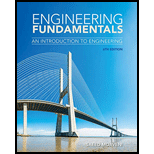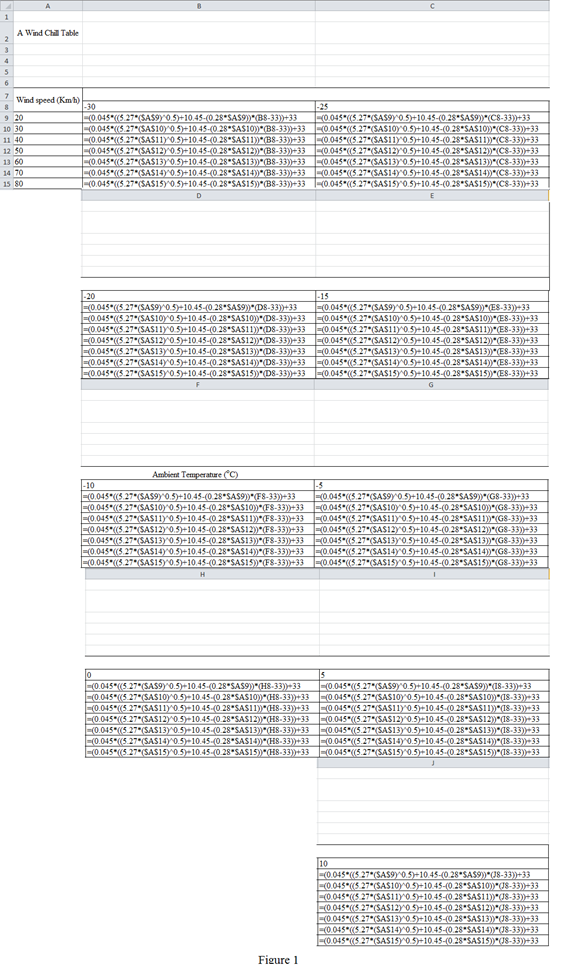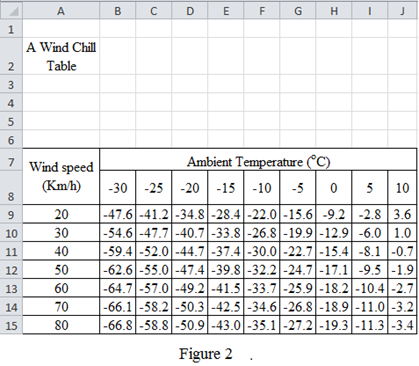
Concept explainers
Create a table that shows the windchill temperatures for the given range of ambient air temperature and wind speed.
Answer to Problem 19P
A table is created for the windchill temperatures with the given range of ambient air temperature and wind speed by using excel.
Explanation of Solution
Given data:
The range of ambient air temperature is
The range of wind speed is
Formula used:
Formula to calculate the more common equivalent windchill temperatures is,
Here,
Calculation:

Refer to the Figure 1:
Column A shows the wind speed (V) with range from
For the cell B9, the formula used to find the equivalent windchill temperatures as “
Written as “=(0.045*((5.27*($A$9)^0.5)+10.45-(0.28*$A$9))*(B8-33))+33”. Here, B8 cell represents the value of ambient air temperature is
For the cell B10, the formula used to find the equivalent windchill temperatures as “
Written as “=(0.045*((5.27*($A$10)^0.5)+10.45-(0.28*$A$10))*(B8-33))+33”. Here, B8 cell represents the value of ambient air temperature is
For the cell B11, the formula used to find the equivalent windchill temperatures as “
Written as “=(0.045*((5.27*($A$11)^0.5)+10.45-(0.28*$A$11))*(B8-33))+33”. Here, B8 cell represents the value of ambient air temperature is
For the cell B12, the formula used to find the equivalent windchill temperatures as “
Written as “=(0.045*((5.27*($A$12)^0.5)+10.45-(0.28*$A$12))*(B8-33))+33”. Here, B8 cell represents the value of ambient air temperature is
For the cell B13, the formula used to find the equivalent windchill temperatures as “
Written as “=(0.045*((5.27*($A$13)^0.5)+10.45-(0.28*$A$13))*(B8-33))+33”. Here, B8 cell represents the value of ambient air temperature is
For the cell B14, the formula used to find the equivalent windchill temperatures as “
Written as “=(0.045*((5.27*($A$14)^0.5)+10.45-(0.28*$A$14))*(B8-33))+33”. Here, B8 cell represents the value of ambient air temperature is
For the cell B15, the formula used to find the equivalent windchill temperatures as “
Written as “=(0.045*((5.27*($A$15)^0.5)+10.45-(0.28*$A$15))*(B8-33))+33”. Here, B8 cell represents the value of ambient air temperature is
Table 1 is created to shows a Wind Chill Temperature.
Table 1
| Wind speed (Km/h) | Ambient Temperature | ||||||||
| -30 | -25 | -20 | -15 | -10 | -5 | 0 | 5 | 10 | |
| 20 | -47.6 | -41.2 | -34.8 | -28.4 | -22.0 | -15.6 | -9.2 | -2.8 | 3.6 |
| 30 | -54.6 | -47.7 | -40.7 | -33.8 | -26.8 | -19.9 | -12.9 | -6.0 | 1.0 |
| 40 | -59.4 | -52.0 | -44.7 | -37.4 | -30.0 | -22.7 | -15.4 | -8.1 | -0.7 |
| 50 | -62.6 | -55.0 | -47.4 | -39.8 | -32.2 | -24.7 | -17.1 | -9.5 | -1.9 |
| 60 | -64.7 | -57.0 | -49.2 | -41.5 | -33.7 | -25.9 | -18.2 | -10.4 | -2.7 |
| 70 | -66.1 | -58.2 | -50.3 | -42.5 | -34.6 | -26.8 | -18.9 | -11.0 | -3.2 |
| 80 | -66.8 | -58.8 | -50.9 | -43.0 | -35.1 | -27.2 | -19.3 | -11.3 | -3.4 |
Figure 2 shows a wind chill table in the excel sheet has obtained as similar to given Problem 14.19 in the textbook

Conclusion:
Hence, a table is created for the windchill temperatures with the given range of an ambient air temperature, and wind speed have been explained using excel.
Want to see more full solutions like this?
Chapter 14 Solutions
Engineering Fundamentals: An Introduction to Engineering
- A project requires 125 cubic yards of concrete sidewalk to be placed, for which 165 workhours have been budgeted. The latest weekly progress report shows that 78 cubic yards have been placed and 103 workhours have been expended to date. What is the status of the concrete placement? Significantly under budget. On budget. Significantly over budget. Status cannot be determined with information supplied.arrow_forwardRefer to exhibit #098. At what depth was water encountered?arrow_forwardWhat is the reaction moment at A for the frame shown? a. 222.1 k-ft b. 107.8 k-ft c. 20.8 k-ft d. 23.25 k-ftarrow_forward
- “When a conflict exists between the project floor plans and detailed material schedule relative to size or number, which of the following usually governs in typical order of precedence?arrow_forwardWhat are the critical activitiesarrow_forwardApproximately how many pounds of water are necessary to hydrate 100 pounds of type I Portland cement? 30 50 75 94arrow_forward
- 7:05 3.1 Trabajo en clase.pptx .III LTE 8 Trabajo en clases 3.1 C9 X 20 W8 X 21 5-15. PL¹× 12 Fy = 50 klb/plg² KL = 16 pies KL 21 pies 2 plg MC 13 × 50 PL × 12 Fy = 42 klb/plg2 Fy = 36 klb/plg² 8 plg K k MC8 × 21.4 KL = 20 piesarrow_forwardThe steel frameword below is used to support the reinforced concrete slab used for an office area above the first storey. The slab is 210 mm thick. Sketch the loading that acts along members BE and FED. Use a = 2.15 m and b = 5.25 m. Refer to the 2024 OBC live load table. The unit weight for the concrete is 24.15 kN/m3.find:Loading for member BE Loading for member FED Live and Dead Loadsarrow_forwardFor the simply supported beam below, draw both the shear force (VFD) and ending moment (BDM) diagrams. Please show all equations and free body diagrams (FBD). Note: I want a cut through each of the three sections of the beam, with all related forces calculated and shown on the VFD and BMD.Reaction Forces Shear Force DiagramMaximum Shear ForceEquation for cut 1, 2, 3 respectively.Confirmation of Reaction ForcesBending Moment DiagramMaximum Bending Momentarrow_forward
- For the structural frame below, draw the shear force (VFD) and bending moment (BMD) diagrams for each of the three members of the frame. The frame is pin connected at A, C and D and fixed at joint B.Find:VFD & BMD for segment AB VFD & BMD for segment BCVFD & BMD for segment CD Reaction Forces VFD Equations BMD EquationsFree Body Diagramsarrow_forwardDetermine the horizontal and vertical reactions at A and C for the two member frame below. Use P1 = 3.2 kN, P2 = 14.5 kN/m, L1 = 3.3 m, and L2 = 2.3 m. Free Body DiagramsTriangular Load Use of Pin Reaction Forcesarrow_forwardDetermine the reaction forces at supports A and C for the compound beam. Assume C is fixed, B is a pin, and A is a roller. Use P1 = 16 kN/m, P2 = 21 kN, L1 = 3.5 m, L2 = 1.5 m, and L3 – 1.5 m. needs:Triangular Load Use of Pin Reaction Forcesfree body diagramsarrow_forward
 Engineering Fundamentals: An Introduction to Engi...Civil EngineeringISBN:9781305084766Author:Saeed MoaveniPublisher:Cengage Learning
Engineering Fundamentals: An Introduction to Engi...Civil EngineeringISBN:9781305084766Author:Saeed MoaveniPublisher:Cengage Learning
